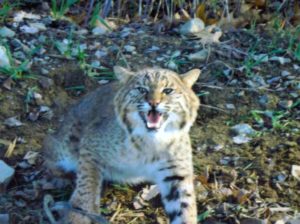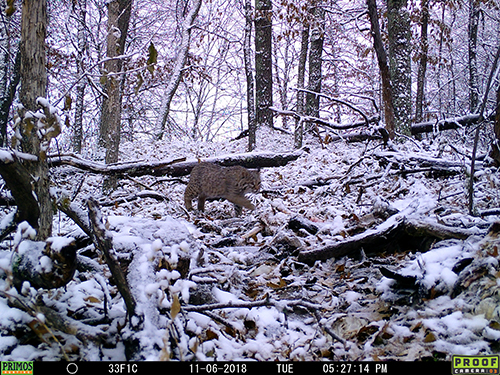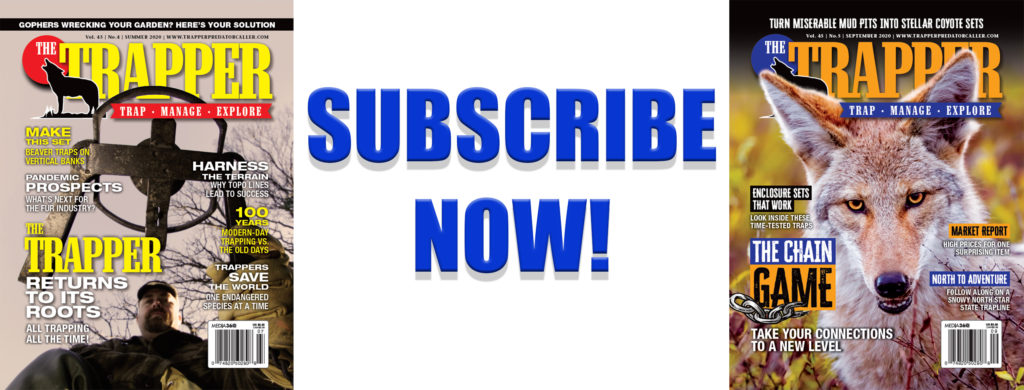By Dave Morelli
I had to walk right up to my set because the tattle tale was not visible against the fresh snow —powder that made my climb more interesting, too.
As I approached, I was certain my trap was gone. But the new snow made it impossible to detect a direction of travel. Almost.
The bush backing the set revealed broken branches and bite marks I could have easily overlooked, because it wasn’t snapped or chewed enough like the critter was hung up long.
I usually tangle the drag in a bush or rocks at bobcat sets to keep the animal nearby. Bobcats don’t usually tear up a set like a coyote, and in the rocky country I trap, I don’t want to track a ‘cat very far, especially in heavy snow.
Traveling in circles, I searched for clues sticking out of the snow. My dog, Trax, was going crazy in the back of the truck. He could probably smell the trail, but I didn’t want him tearing up any crucial evidence before I had a time to check it out.
I discovered more broken sagebrush and bite marks 50 feet from the set. It didn’t look like the critter was hung up very long there, either. I couldn’t see movement in the brush in that direction, so it was looking like time to unleash Trax.
My dog quickly confirmed the direction of travel and beelined to a bush 75 yards down the hill as if a movie director gave him the script to read first.
Trax must not have finished reading the script, though, because the dog foolishly stuck his head under the bush. A bobcat’s razor claws and grouchy disposition greeted Trax. The tom turned out to be the second largest cat of the season for me, putting me on the positive side of the fur buyer’s ledger.
Summer Homework Spells Success
As I removed the bobcat from the trap, I thought about my summer scouting visit. One of the most important factors in running a successful ‘cat line is what I call “homework.”
Although catching bobcats involves many factors, finding them is the most important. The second important factor is having everything ready when the season starts. Bobcat season is too short to be prying frozen rocks out of the ground for stepping guides, cutting brush for trail blocks and walking around in circles looking for a perfect spot. I accomplish those tasks while scouting.
After I find the spot I think a bobcat will walk through, I imagine the set in my mind. If possible, I construct the set, minus the trap.
When I return, all I have to do is set the trap and lure the set.
If I am not quite sure how I will set it up because of snow conditions, I cut stepping sticks and pull up rocks, placing them on a larger rock so they will not freeze in. If a trail needs to be blocked, I do it in preseason to save time while I’m trapping. Plus, bobcats will become used to waking the direction I want them to travel.
I usually walk more during bobcat season than when I’m coyote trapping, so any time I can save is valuable. Less time at the set also means less opportunities for me to be picked out by a rival trapper. The quicker I get in and out, the less chance of being busted. A bobcat won’t sell its location like a struggling coyote, and I like to keep my set locations to myself.
Become a Bobcat Analyst
Finding the perfect spot for bobcats is much like the satellite-viewing scenes in a CIA-type action show: The analysts start out with a overall picture, then enlarge just a block, then a house, then the girl by the pool in the back yard. Cat locations are found the same way.
First, I find a section of country that looks good. Rocky canyons, draws and areas of tall sagebrush are good places to start. Bobcats habitually travel in areas with good cover so they can survey hunting grounds from an ambush position.
Then, I zoom in to look for spots that funnel or direct the predator travel. I am also analyzing the area for access and the equipment needed to get to the set. Even though I usually walk, knowing what vehicle I might need as the season progresses can also save time.
After I’ve narrowed my search to a particular funnel, it’s time to identify set locations. In areas where the ‘cats might have to cross an open area from draw to draw, I look for a set location in the first cover that protrudes from the area the animals will be heading into.
In thick cover, I look for places where rocks and other structures narrow the path and create interest points. Eye-catching structures between cover areas should also be investigated.
When I narrow my search narrowed to this point, it is time identify the exact spot for the pan, and to determine how many traps I need to cover the area. I keep notes on each area, the type of sets and the materials I will need. I don’t want to walk in again only to find I don’t have what I need.
From Theory to the Field
One of the biggest toms I have caught was in an area I found using this TV show mentality.
I could see the rocky structure from the highway, and it looked like ‘cat country. The closer I got, the more I narrowed to specific locations. Finally, I found a trail set along a huge rock just a bit up the hill from the canyon floor.
The face of the rock had sagebrush cover in front of it. I figured a bobcat could walk between the rock and the brush while scouting for game. The slight rise up the canyon wall gave the ‘cat a good overview of the hunting ground.
My catch came on another morning with fresh snow that made the ground slippery as I worked my way up the road to the set. It was two days after Christmas, and I was about to be gifted with a great tom.
It was a short walk to the first set. Even though it was not visible with the naked eye, my optics told me there was a bobcat in the set. I am never without binoculars on the trapline. In fact, I have a truck set and a pocket set. Nothing saves me more miles than my binoculars.
I’ve learned that the farther the set is up a hill, the more time I should take to place a tattle tale. A tattle tale is a noticeable object at the set that will indicate something disturbed the trap.
One of my favorite tattle tales is a stick I have wrapped the chain around and placed in a bush. If an animal pulls the trap from the bed, the stick will fall and I won’t be able to see it. A long stick leaning against a rock close enough to be knocked over by a struggling critter is another good tattle tale.
Like many bobcats, the big tom was sitting perfectly still. It never moved until I got right up to it.
After dispatching the ‘cat, I checked farther up in the rocks for the tattle tale at another set. It was gone.
I walked up to the set and found a few chewed sticks. New snow made it hard to determine a direction of travel.
Then, I spotted a pile of coyote scat next to the set. The only reason it was visible was because it was next to the bush that blocked it from being covered with snow.
My vision of a double on ‘cats was drifting away, and ol’ Trax confirmed my theory when he started scuffling with a coyote hung up in sagebrush 100 yards away.
I set most of my bobcat locations with exposed traps. Sometimes, I don’t even use a pan cover.
Most of them are blind and trail sets. The bare trap is camouflaged with sticks and the guiding is too heavy for most coyotes. However, I still caught three coyotes and five foxes in bobcat sets this year.
I make the sets to try to avoid coyotes, because I would rather the set be available for a passing bobcat, but sometimes the canines still find the pan. I was happy for the bobcat-coyote double. Preseason scouting paid off.
Don’t Stop Scouting
I found a great spot — or so I thought — trapping bobcats two years ago. Even though I worked it all season without a catch, I decided to give it another chance.
But this time, I scouted the area better than I did the previous year and found great places where the trails narrowed because of structure.
My wife, Lu, takes all of my pictures. At the time, she was starting to get into the swing of finding good specific sets. She picked the location that hit paydirt.
I had made the obvious set and narrowed it down with sagebrush during my preseason scouting. But when we set the area, Lu picked a spot just ahead of the set. It looked good, so I tailored it for another trail set.
On the fourth check, fresh snow revealed a bobcat had climbed through the sagebrush and sticks to avoid my first set. However, the set Lu picked out 25 yards away had connected.
I quickly pointed out to her it wasn’t as big as the tom I caught in the my previous set, though.
Flat Sets Near the Pantry
Most of the catches I made last season came in trail sets, but flat sets in the rocks also paid off.
Not really a cubby, my flat sets are usually near a visible hole in the rocks that could hold rats, mice and other delectables that would interest a hungry bobcat.
I usually set the trails into these areas with snares and blind sets, too. The snares pick up marauding coyotes, keeping the flat sets open for the kitties.
Most of my catches occurred when the overnight lows plummeted. I had a two-bobcat day when the temperature hit 20 below zero at night.
It seems bobcats hunt or move more in the cold — or maybe it’s just coincidence.
When I’m picking spots for bobcats, I don’t worry about water sources like I do for coyotes. Bobcats seem to get by in areas without open water in the winter, as long as there is a food source.
The prey is key. When I’m scouting, I look for prey species’ tracks more than bobcat tracks.
Sure, it’s a shot in the arm to find a ‘cat scratch or a track, but it doesn’t happen often enough to justify only setting those locations. I wouldn’t put out many traps.
Instead, I look for areas the areas bobcats will frequent. In winter, food sources are only one step behind cover in importance. Areas with high populations of rabbits or mice are hotspots, especially if cover is near.
Scouting Brings $$
Last year was a banner season. I did well on ‘cats — in numbers and price — and even let a few smaller bobs go. I don’t think it hurts to let a few go for seed.
I also managed to hold a mountain lion in one set. Lu got a kick out of seeing the big feline. I had released them before, but it was her first close encounter with a cougar.
I only abandoned two spots because of weather, only got stuck twice and I slipped and hit the rocks twice. And in the end, all of the work seemed to melt away like snow in the spring when the fur buyer wrote out the check.
The Trapper contributor, Dave Morelli, hails from Idaho.





Hello. I really enjoyed this article and had some questions. As someone preparing to start trapping, I want to do my research in advance so I’m as prepared as I can be. I don’t mind being outdoors, so if I don’t get anything, at least I’ll have enjoyed the countryside, but a catch is nice too.
My questions. Is there a certain trap size I should use for cats? Did you bait the traps or simply set them where animals would be channeled? Do you skin out your cats or do buyers prefer to do that? Do they prefer brain tanned or the whole pH process, or another method (does it matter)? Should I trap a specific area every season or should I let it be the population can have a chance to rebound? You mentioned you caught a mountain lion and let it go. How on earth did you do that? You also mentioned you let some smaller cats go. Can they recover from the impact of being in a trap? Do you have a diagram of how to channel and how to properly set up a set?
Thanks so much. I truly enjoyed this article. It got me dreaming of getting out and back to the things I love to do.
Be well.
Shiloh
I also thought this was a very informant article. I use Bridger # 3 4 coil. Missed a lot on 2coil. Another thing check your regs too I prefer the non offset jaws but some states require offset jaws. I prefer not to bait but to use a good lure and a good call. Using bait to me causes a lot of birds and critters you don’t want in traps. Good luck. Also check with your fur buyer to how’s he wants cats preserved.